Description: War Thunder is a next generation military MMO game dedicated to...

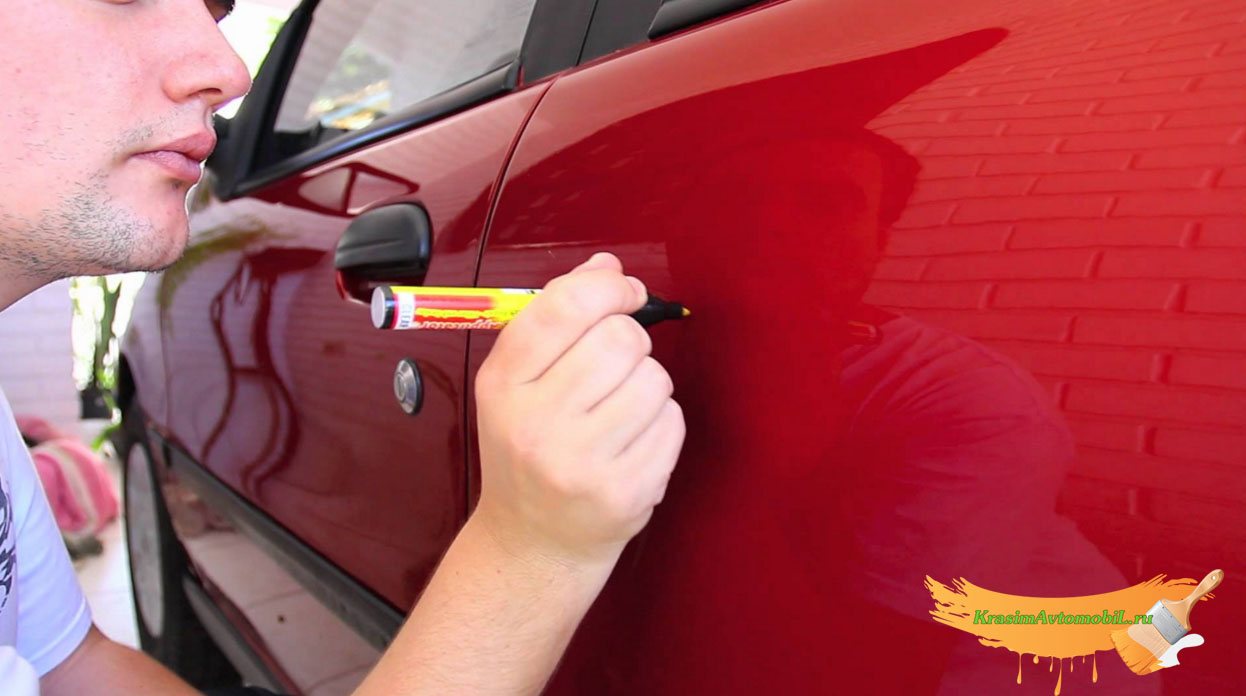
03.09.2016 14932
Minor scratches and chips do not prevent the car from driving, but deprive it of aesthetics appearance, annoy the car owner, lower the status new car. Contacting a service station for painting and car costs a lot of money, and an independent local repair of paint and varnish coatings can be a way out.

Modern paint coatings have increased durability, combining hardness with elasticity. But the lifestyle involves aggressive driving, so scratches and chips on the car's paintwork are a frequent annoying occurrence. The reasons for their appearance are familiar to every motorist: gravel impacts on the body, hasty careless parking, friction of branches when traveling in a forest zone, accidents plus the effect of salt reagents and sand on the coating in winter period. As a result, restoration of the car body is required - in order to minor damage did not entail major problems, provoking the spread of corrosion.
Restoration of paint and varnish from the depth and nature of damage, as well as the choice of materials suitable for eliminating defects.
Local damages are defects, the area of which occupies less than 30% of the part surface. They are divided by size, depth and time of appearance into several types:
Repair technology paintwork directly depends on the type of damage:
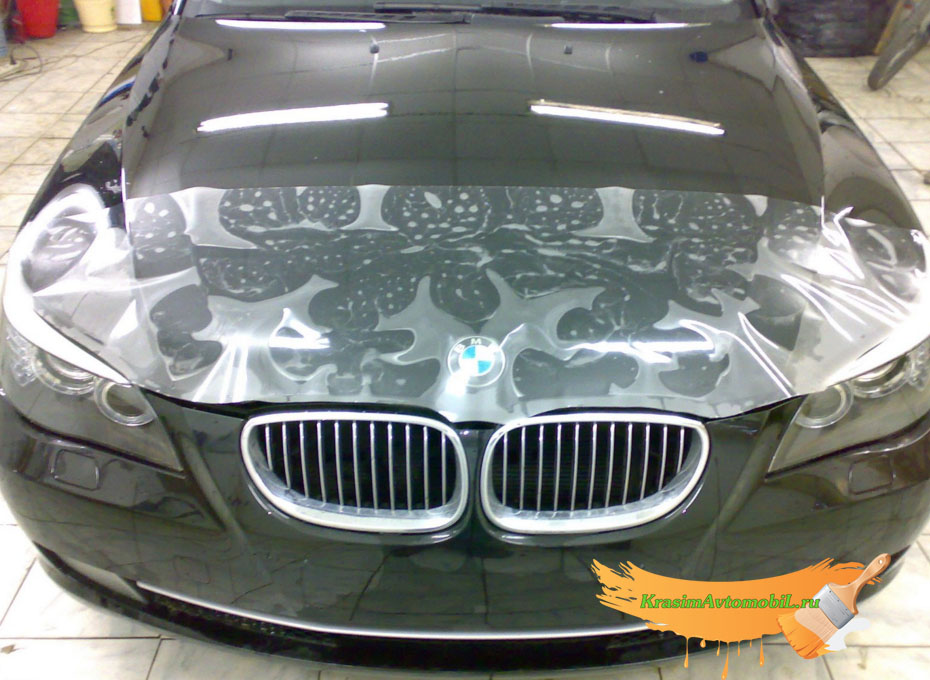
The paint layer of any car is dotted with longitudinal and concentric small scratches, cobwebs, cracks, scuffs. These damages are superficial, do not reduce the protective properties of the paintwork, but unpleasantly spoil the appearance, aging the car. Micro-scratches on a car body are inevitable - sometimes an unsuccessful touch with clothing items is enough to leave a mark on the paintwork. Even for careful owners, the car body is dotted with scratches due to a thorough washing. There are several ways to restore the car's paintwork, including polishing and masking with cosmetics.
Advice. The most inexpensive means for masking shallow small scratches, cobwebs, scratches is an auto marker, or a tinting pencil. This tool is rather decorative; other methods are used for serious restoration of damage.
One of the most common methods is polishing. It should be remembered that it can be done a limited number of times, since each subsequent exposure depletes the paintwork. Repairing scratches on a car using polishing is carried out manually or using a grinder. First, check the depth of the scratch with a fingernail - if the damage is noticeable and the nail clings to the edges, restore the varnish coating on the car by polishing will fail. To remove scratches on the car body, you will need abrasive sandpaper 3000, polishing paste, water in a spray bottle, a sponge or a soft cloth. Before polishing, the car is washed, sandpaper and the surface of the car are moistened with water before starting work - so that it does not heat up, and the dirt rolls off.
Then they begin to clean up the scratches. They work with sandpaper carefully, especially if they use a grinder - pressing too hard will damage the paintwork layer and ruin the car. The top thin layer of varnish is removed, then the place is wiped dry with a rag. The treated area of the varnish becomes matte, to remove the matte effect, an abrasive polish is used. It is applied with a rag or a dry sponge, rubbed into the surface without strong pressure, finally doused with water, wiped dry.
Finishing is carried out with a protective gloss restorer - a composition is applied to a cloth or sponge, which is rubbed into the surface. Polishing is carried out with correctly set directional lighting - a spot light helps the polisher to see all the realities of the surface to be treated.
To temporarily restore the paintwork, eliminate micro-scratches and cobwebs, you can use a commercially available kit for removing scratches from a car, with which cosmetic defects are masked. The standard kit includes a polishing paste of the corresponding color, battery-operated manual polishing, a nozzle-sponge, a microfiber cloth, gloves. Reviews of car owners about such kits: the kit can be used for masking small scratches, temporary restoration of the paintwork, but the results of the restoration are washed off after several car washes.
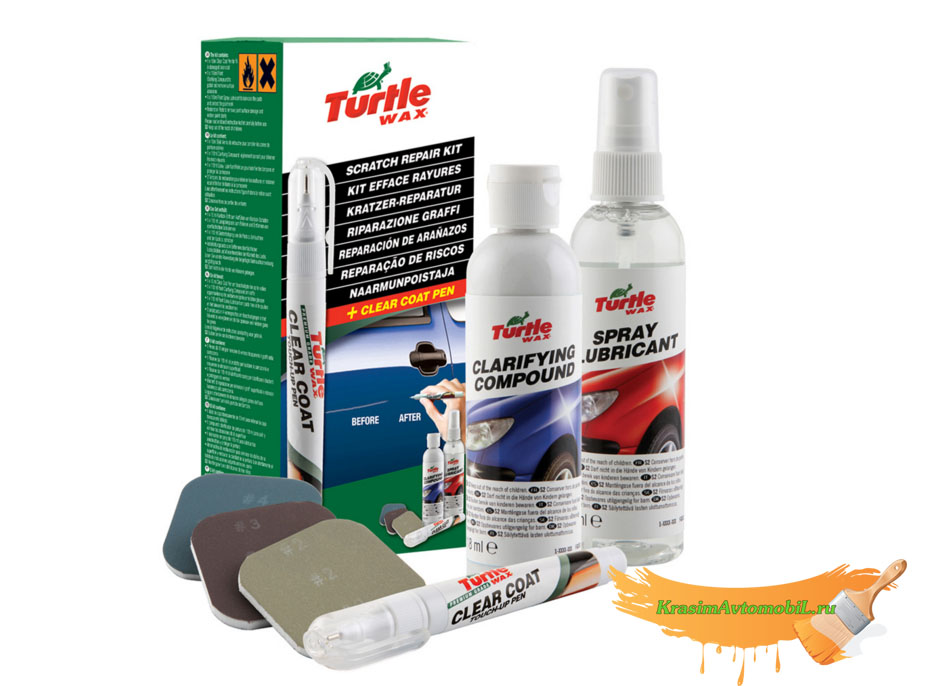
For quick and thorough restoration of medium-sized scratches, abrasions, cracks, there are effective means to remove scratches - repair paints, for example. MOTP. They provide durable protection against corrosion, are available in the form of 400 ml aerosol cans and 12 ml retouches. Repair paints are used to paint over defects and restore. For this, you need 2 cylinders - paint plus varnish. them are positive. The cost of the compositions is low, and a large variety of shades ensures an accurate hit in the factory original colors.
The technology of work is very simple - the surface is cleaned, degreased, and then varnished on it, after it dries. If there are deep scratches, they are puttied, an aerosol primer-filler is applied on top, and then paint and varnish are sprayed. If repair of a plastic surface (for example, a bumper) is required, special paints for plastic are used. Their feature is the mandatory use of primer, on which paint is applied, and finally varnish.
Local repair of the paintwork is carried out with small but noticeable damage to the paintwork on the parts - the most common type of defects that every car owner faces. Repair of the car's paintwork will require a whole range of works - from cleaning the damage site to the substrate, puttying and painting. The restoration of the paintwork begins with the localization of the site - the restriction of adhesive tape, pasting with a protective film or paper on areas that are not planned to be affected.
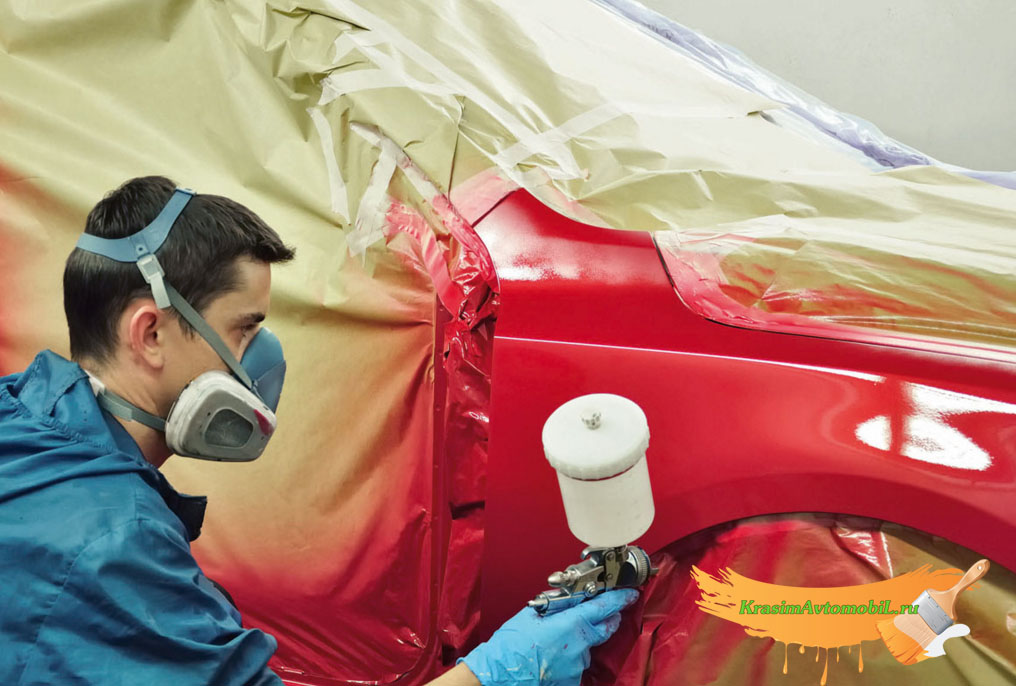
The next preparatory step is a thorough degreasing of the surface (alcohol solution) so that dirt, grease or silicone does not fall into the risk of damage - they can later cause peeling of the applied coating.
To prepare the surface for puttying, it is sanded down to the substrate. Grind with a P180 abrasive wheel slightly beyond its damage boundaries (by 2-3 cm) to smooth out the existing irregularities and ensure a smooth transition. The remains of grinding dust are blown off with air, the area is passed with grinding material on a foam base with the same P180 gradation and again cleaned of dust. The old base is demolished to the substrate, then the surface is degreased and dried.
On a prepared base. Before use, the putty composition is mixed until a homogeneous consistency, since polyester resins and filler are separated during storage. Before applying, a hardener is added to the putty - they work with two spatulas, mixing the composition with chopping movements (not rotational, so that air does not get into the composition). After mixing, the putty is applied to the base in a thin layer and dried.
Then the putty layer is ground, preparing for priming. Grinding is carried out with P280 abrasive (it is possible to use from 220 to 320).
The polished layer is degreased, small specks are removed with a sticky napkin. The next step is to apply a primer diluted according to the instructions. To mix the compositions, measuring containers are used, the soil brought to the desired viscosity is poured into the spray gun and sprayed onto the surface in two layers - one light, the other denser. The primer is cleaned with P500 abrasive and degreased.
The restoration of the paintwork of the car is completed by applying new layers of paint and varnish using an airbrush.
Repair of car paintwork chips reaching the ground is carried out immediately after they appear due to the destructive effect of the external environment on the metal. It is necessary to tint the chips, otherwise they may “bloom”. Drying time approx. 2 hours, in summer high temperature repair of chipped paintwork can be done even faster.
To remove a small chip, you need aerosol enamel, degreaser,. To begin with, they wipe the surface, spray the rust solvent on the chip and clean all the rust out of the scratch. Then they wipe the chip with a degreaser, take a little paint with the tip of a toothpick and fill the chip just above the level of the main paintwork, since it sinks when it dries. Leave to dry - a couple of days after complete polymerization, the hardened cleavage site is treated with a polish.
WATCH THE VIDEO INSTRUCTIONS
If scratches, chips, abrasions and other damage occurred without dents and surface deformations, it is possible to restore the car's paintwork on your own, and at low cost.
In the ideal operation of the car, the repair of the surface of the varnish and paint, logically, should be carried out extremely rarely. But even such careful operation is preceded by "garage" and factory painting, the quality of which is directly related to the durability of the metal. It is possible to increase the interval between major repairs only by restoring the paintwork (LKP) of the car without painting. The essence of the work is the polishing of minor scratches, followed by the application of protective agents. If you carry out the processing of defects and protection of the paintwork in time, then you will not have to visit the workshops due to traces of corrosion, clouding of the varnish layer or peeling and cracking of the varnish.
Regardless of how well the primary painting was carried out, the gloss of the paintwork disappears over time. This happens due to evaporation or mechanical removal of the oily substances that make up the composition. modern means, to enhance their reflective abilities. At the present time, methods are used both to prevent the evaporation of such substances, and to restore the faded paintwork. Modern technologies can solve these two tasks during the repair at the same time. The paintwork can be restored to its original brilliance only by removing a small layer from it. You can do this in several ways:
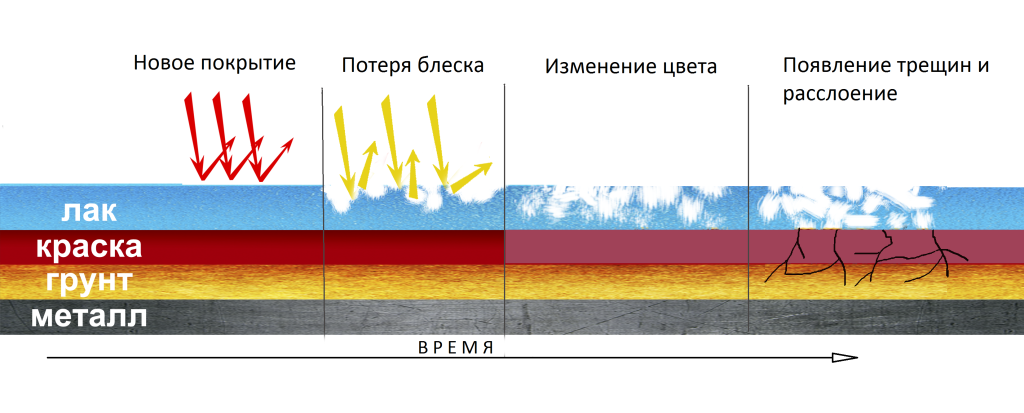 When applying chemicals to paint without varnish, be extremely careful, because. most of these surfaces immediately absorb chemicals, which is absolutely undesirable. Therefore, polishing is often used to remove the top layer from paints. Let us describe the basic principles of polishing, since mechanical polishing and manual polishing require detailed lighting. So:
When applying chemicals to paint without varnish, be extremely careful, because. most of these surfaces immediately absorb chemicals, which is absolutely undesirable. Therefore, polishing is often used to remove the top layer from paints. Let us describe the basic principles of polishing, since mechanical polishing and manual polishing require detailed lighting. So:
Polymerization of acrylics, even the fastest ones, lasts about 20 - 30 days, and the evaporation of solvents from many other materials is possible even longer. You can polish the car body after a couple of hours after complete drying, and it is advisable to use chemistry no earlier than one to two months. After this time, the driver can already use the following aggressive substances against pollutants:
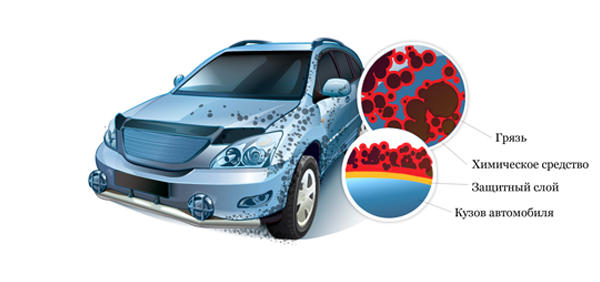 From the list above, it can be seen that each chemical agent has its own neutralizer. For example, traces of wood resins can be removed with kerosene and similar substances, and swelling of the paintwork is removed by heating the car, and solid mastics are used for the final fixation. It is another matter if the damage is mechanical or gloss is lost after a while - this problem can be solved by polishing. Gloss can be restored without prior polishing, but often defects are eliminated only by mechanical processing.
From the list above, it can be seen that each chemical agent has its own neutralizer. For example, traces of wood resins can be removed with kerosene and similar substances, and swelling of the paintwork is removed by heating the car, and solid mastics are used for the final fixation. It is another matter if the damage is mechanical or gloss is lost after a while - this problem can be solved by polishing. Gloss can be restored without prior polishing, but often defects are eliminated only by mechanical processing.
Before you start restoring the paintwork without painting, it is necessary to determine the nature of the damage and the required composition of the polish. Let's consider some of them:
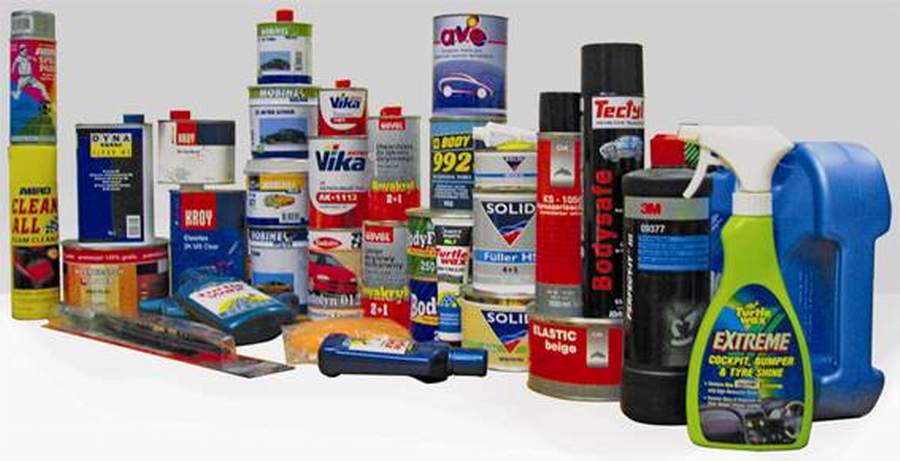 Characteristics of polishes and their purpose:
Characteristics of polishes and their purpose:
The use of abrasive polishes is carried out only if there is no significant damage to the paintwork. If the damage has reached the soil layer, an abrasive polish will not help. Puttying will be required, followed by painting the damaged part.
Protective polishes do not always return the original shine to the car. Often for this purpose it is necessary to remove the top layer of the paintwork. The thickness of the current painting can be in the range of 30 - 100 microns. Therefore, when choosing a polish and a material for its application, consider the thickness of the repairable surface.
Distinguish polishing with the use of a polishing machine and without. AT last case the polish is applied with your own hands on the paintwork with a soft sponge, but only after the body has been thoroughly cleaned of dirt. When working with a polishing machine, do not forget to evenly distribute the polish over the surface and do not polish one area for a long time, because. may be overheating of the paintwork. And to remove such a defect, abrasive polishing is required.
 During polishing, the remains of the polish should be removed from the surface of the body with a damp cloth (microfiber). Restoration should be carried out in small sections, without going in cycles in polishing along the same route. This can lead to the formation of "corners", "circles" and other troubles on the car. After drying, all residues must be removed with a soft cloth - the nature of the movements is free.
During polishing, the remains of the polish should be removed from the surface of the body with a damp cloth (microfiber). Restoration should be carried out in small sections, without going in cycles in polishing along the same route. This can lead to the formation of "corners", "circles" and other troubles on the car. After drying, all residues must be removed with a soft cloth - the nature of the movements is free.
Any damage to the car body is a problem that needs to be addressed urgently. Chips and scratches, peeling paint and swollen bodywork - all this does not make the car more beautiful, reduces its real value and seriously affects the pleasure of operation. In addition, the corrosion that occurs in these places spreads very quickly, and after a while it will attack the entire body part, and then other body parts of your car. So restoring the paintwork of the car is simply necessary. This is exactly the task that will save the body for a long time, protect it from rust and other unpleasant manifestations. Interestingly, even a handicraft inept repair method can stop corrosion, even if it does not restore the pleasant appearance of the car.
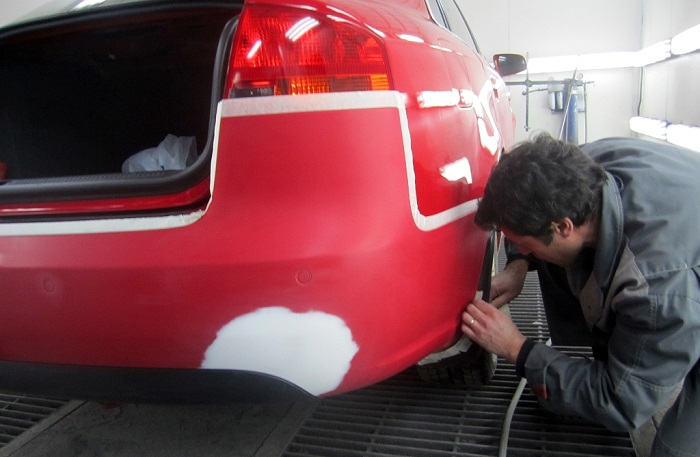
There are many types of car damage, on which the features of body restoration depend. You can just paint over a small scratch, or you can restore the car after significant problems, an accident or other unpleasant moments. So in each case you need an individual approach that will provide you with the necessary conditions for using the machine. In each situation, it is necessary to approach the solution of the problems that have arisen, taking into account the damage itself, as well as the resources that are available. It's great if you have a spray booth at your disposal, but sometimes problems have to be solved just in the open air, and then it makes sense to resort to various human tricks and tricks.
Many refer to chips and small scratches quite coldly - these are normal consequences of car operation. Indeed, during the trip on your car, you will not be able to avoid such troubles. However, problems need to be fixed. This is the main reason for the spread of corrosive damage to the body. If you do not pay attention to a deep chip in time, you can allow the metal to be damaged by rust, which will begin to develop under the paint. Therefore, it is better to immediately repair the chip and scratch. The optimal chip repair process is as follows:
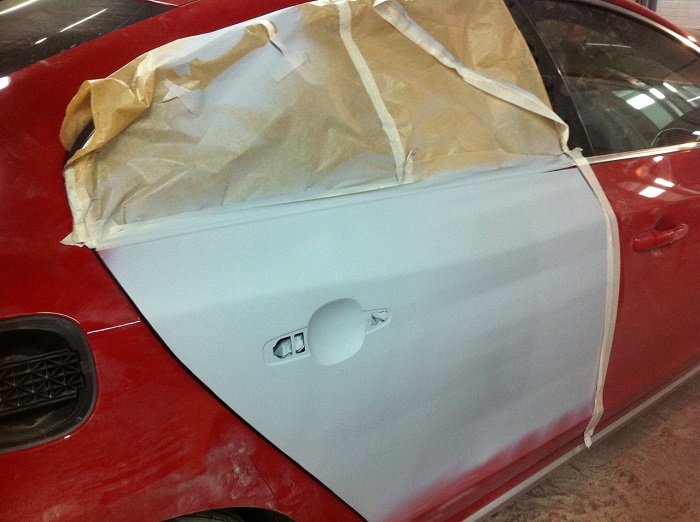
With the help of such a procedure, you definitely cannot eliminate visual problems with a chip. The place of damage will remain noticeable, sometimes it will be evident. But you can stop the development of corrosion or significantly slow it down. This is a very important process that will keep the car body intact. It is also very interesting that in most cases, chips and scratches are repaired without the obligatory cleaning, degreasing with a solvent and removing rust with sandpaper or a sharp object. In such situations, the body remains unprepared, the applied paint quickly disappears.
If your car has suffered some incomprehensible damage from heavy use or poor quality paintwork, you can use various repair tools and achieve excellent results using the most affordable restoration options. It must be admitted that in most cases, high-quality repairs of deep damage are performed only at the service, however, many car owners will be able to do this in a regular garage. When we are talking about severe damage, you will have to clean up the place of the chipped or cracked paint, removing all the elements that have already managed to move away from the body. If there is a whole primer left under the paint, you are in luck, but often the primer comes off with the paint. The procedure for repairing such damage is quite simple:
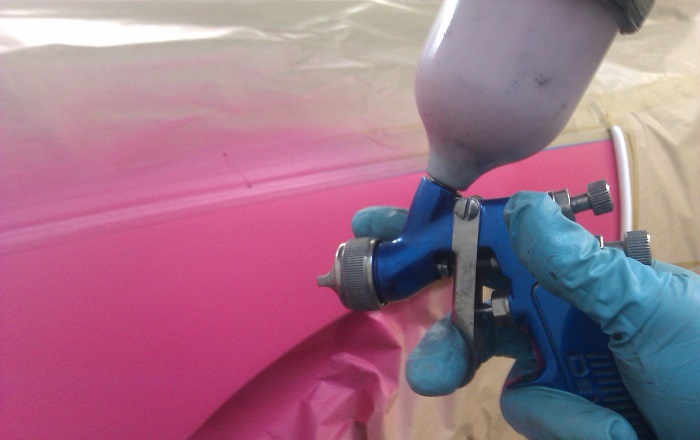
Most likely, self-repair will be visible to the naked eye. It all depends on the selection of paint, its quality, as well as the polishing carried out correctly and on time. Often, even in garage conditions, it turns out to achieve an excellent result. You can use the services of a specialist and fix these problems quickly enough. For such work, a professional contractor will not charge you too much money, and will not require you to provide a car for several weeks. All tasks are completed in one day.
A professional spray booth, a worthy experience of the people who work in it, as well as the possibility of high-quality paint selection - these are the advantages that gives us professional painting on the service. You can easily repair chips and scratches, damage after minor accidents or other troubles, but in most cases you will not be able to achieve the desired result visually. Specialists do their work taking into account the final result. Among the important stages that professionals use in local body repair, the following processes can be distinguished:
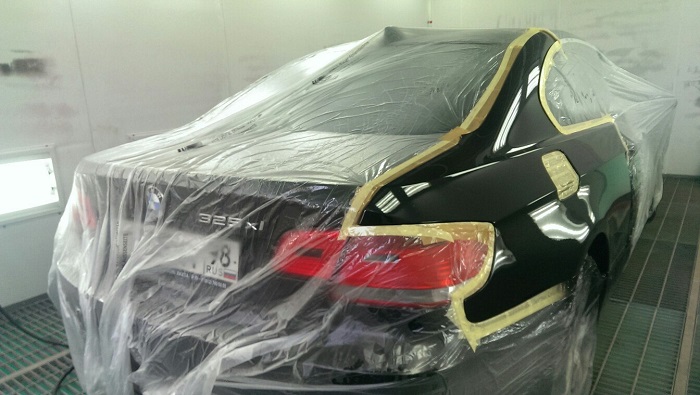
Also, specialists carry out polishing of the body, high-quality preparation of the painted surface for delivery to the owner. As a result, not only will you not visually notice the place of repair, but you will also be able to operate your car for a long time with the help of professional services. It is interesting that in many situations you will spend on the work of the master not more money than self-repair. The fact is that the master has all necessary tools and you need to get them somewhere. Renting and buying everything you need will become the main source of expenses, so you risk spending no less than you would pay a specialist at a service station. We suggest you watch the process of painting the local part of the body on the following video:
The quality condition of the body is an important aspect of car operation. Nowadays, it is necessary to understand that each transport can be reliable and durable if properly looked after. it important point, which turns out to be quite important in all aspects for the driver. The less attention to the car, the faster it will require serious investments. This truth has already been studied by many professional and experienced drivers who pay attention to any minor paint chip, to any problems with the body that can only arise with the car during operation.
If you happened to deal with the problems of poor-quality paintwork or the consequences of mechanical damage to the body, think about who to entrust this process to. Doing the work yourself is sometimes inappropriate, especially if you do not have any tools to complete this process. Contact a specialized service station that offers such services and get the necessary results of the work carried out on your car. How do you deal with chips and scratches on the body of your car?
If you have been involved in a traffic accident, your vehicle has been hit by a tree branch, hit by a ball, or your vehicle has been left uncovered in a hailstorm, the paintwork on individual parts may be damaged.
In case of damage to individual parts, it makes no sense to resort to full painting of the car, with shallow scratches and dents, you can use polishing or repairing dents without painting, but when the paintwork is badly damaged, there are creases and cracks, but only on individual parts, then local painting of the car - the best solution.
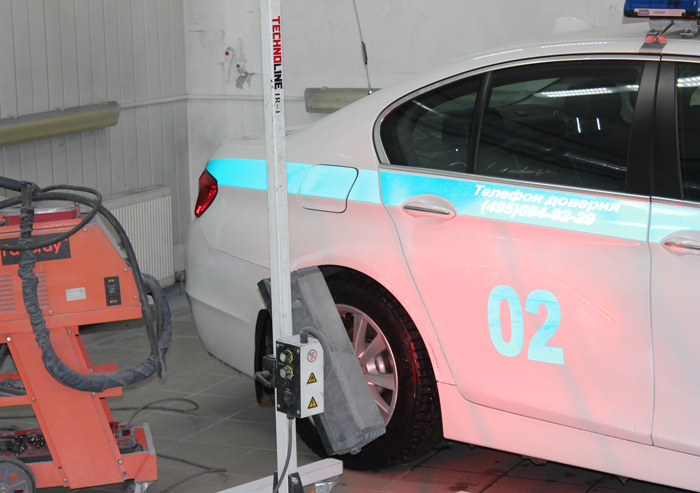
Main advantages local painting cars are obvious:
The technology of local painting has been used and perfected by our craftsmen for almost 10 years - since the opening of our local repair center in Moscow in 2006.
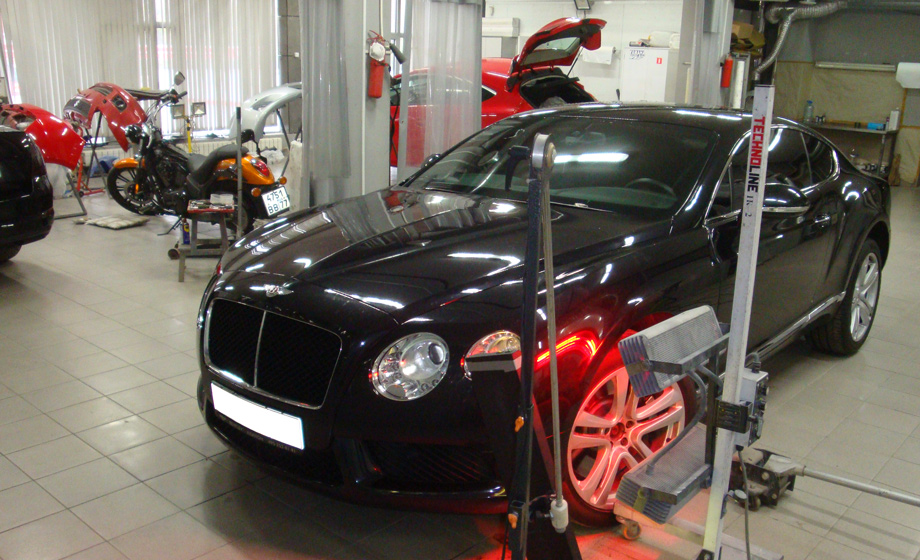
We use innovative 3M products to improve technological processes
Using quality materials allows us to guarantee the quality of our work.
Cromax® is the new trademark for the legendary DuPont Refinish products.
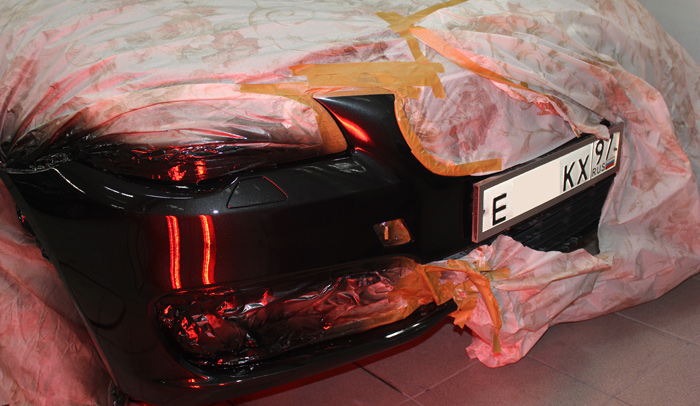
Our team of masters performs local painting in Moscow from 4000 rubles in full compliance with technological requirements and uses the latest and best materials on the market, which always ensures the achievement of the desired result.
Our experts will be able to assess the need and possibility of local painting. And it is not necessary to go through all of Moscow - it is quite simple